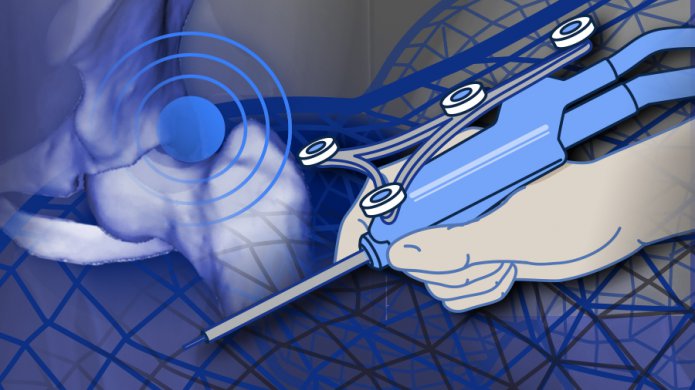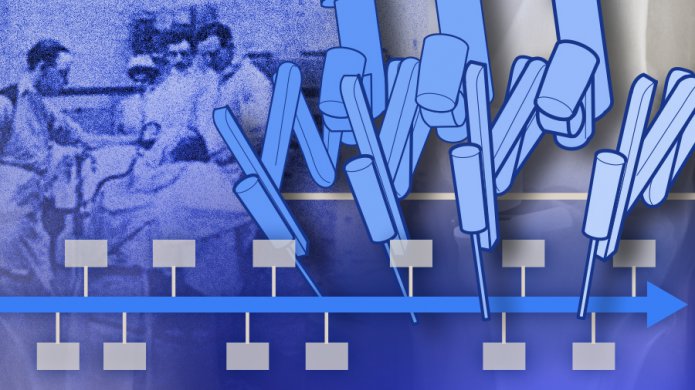Computer-assisted surgery: Current use in hips and knees
Preview
Part 2 examines the current use of computer-assisted systems in hip and knee surgery. Weighing the pros and cons, we look at benefits, economic considerations, limitations, concerns, and impact on patient outcomes. We also reveal how orthopedic surgeons are using these technologies in the operating rooms right now and how they perform after simulation training.
Globally, the number of total hip (THA) and knee arthroplasties (TKA) performed each year is increasing [1–3]. They can be life changing procedures that, when successful, alleviate pain from conditions such as osteoarthritis, and return mobility to patients. Finding new ways to improve patient outcomes is of highest priority for healthcare systems and surgeons.
From CAS to CAOS
In Part 2 of this Insights Newsletter, we narrow our focus to computer-assisted orthopedic surgery (CAOS) systems currently used for hip and knee surgery. Part 1 introduced the different types of navigation and robotic systems used in CAS, their classification, applications, historical background, and terminology.
Orthopedic surgeons are seeing an increasing availability of CAOS systems to train them, support and guide preoperative planning, and even conduct procedures with a robotic “partner” [4]. A study that looked at the use of navigation and robot-assisted surgery in TKAs in the US between 2005 and 2014, found that by 2014, 7% of the country’s TKAs involved navigation or robots compared with 1.2% in 2005. Robots were more likely to be involved in TKAs performed in the Northeast of the country, while navigation was more likely to be used in the Western states [3]. The Australian National Joint Replacement Registry showed that in 2012, 22.8% of all primary TKAs in the country were performed using navigation—an increase from 2.4% in 2003 [5]. Similar trends have been identified in the number of computer-assisted total hip arthroplasties (THAs) [6].
Surgeon training
For most complicated procedures there is an acknowledged benefit to practice. Surgery combines a honed skill set of cognitive, communication, and manual abilities that require training and ongoing practice. For many years, surgical skills have been taught via the master-apprentice model [7] with sheer volume of exposure building competence [8]. However, with decreased working hours, and increasing hospital costs and jurisdictional restrictions, it can be challenging for trainee surgeons to accumulate hand-on experience [9]. A 2019 study found surgeon experience level to be a risk factor in primary TKA malalignment, with trainee surgeons and low-volume non-trainee surgeons performing similarly [10].

Justin Chang
University College London Hospital
London, United Kingdom
For Justin Chang, Senior Clinical Fellow, University College London Hospital, UK, using computer navigation and robotic software as learning tools, particularly for knees, “can help trainees understand principles of balancing a knee. It provides visual and objective measurements for something that is usually learned by subjective feel.”
In terms of robot-assisted surgery, “the learning curve is primarily getting familiar to the functionality and registration of the robot. Surgical outcomes are generally less affected early in the learning curve because the robot ensures components are aligned in the planned position,” says Justin Chang.
Orthopedics is considered high risk for malpractice claims [11, 12]. In France, orthopedic patients make 20% of malpractice claims [13]. Being able to train to a standardized level of competence before having access to patients is an attractive prospect. Training tools have been developed for surgeons that offer the opportunity to practice the skills needed to improve operative accuracy and potentially decrease complications, without having to touch a patient [14].
Virtual reality
CAOS training systems that employ virtual reality (VR), which is a completely simulated experience, offer highly interactive simulations without the need of supervision, with benefits offered to both trainee and practicing orthopedic surgeons [15]. Indeed, simulation training is something that residents have indicated they are interested in accessing [16].
Studies into the effectiveness of VR simulation training in orthopedics have found that the simulation-trained orthopedic surgeons, particularly trainees, were more surgically accurate when conducting the procedure [8, 17, 18]. It also offers a way to assess basic competency before operating on a patient [19].
Efficacy of CAOS
Without adequate research it is not possible to evaluate the degree to which a technology or procedure is effective in meeting its goals. Despite growing adoption of CAOS systems, they are still not available to many surgeons around the world, particularly in less urban environments.
Justin Chang notes that this is due in part to “cost being an important factor which may limit the ability to use robotic surgery, and the operative time is usually longer as well.”
What evidence is there to support or refute the use of CAOS navigation and robot systems in hip and knee surgery? Let's examine some findings.
CAUTIONARY NOTE FROM JUSTIN CHANG: CAOS does not replace surgeon skill
“Technological assists are no replacement for understanding how to apply the fundamentals of orthopedic practice. Learning the basic principles and standard guides is very important. If the software fails or the array positions are knocked mid-procedure, conversion to standard instrumentation may be necessary. Surgeons must have the skills to quickly adapt in this type of situation.”
Read the full article with your AO login
- CAOS in TKA
- Navigation in TKA
- A note on planning software for knees
- Robot-assisted TKA
- Navigation and robot-assisted unicompartimental knee arthroplasty
- CAOS in THA
- Navigation in THA
- Navigated THA
- Robot-assisted THA
- Patient-specific instruments
- PSI in TKA: Cutting jig inaccuracies
- 3D printed PSI and high tibial osteotomy
- CAOS economic considerations
- Considerations before a CAOS purchase
- CAOS systems for use in hips and knees
- Conclusion
- References
Additional AO resources on this topic
Access videos, tools, and other assets to learn more about this topic.
- Video: Robotics and Other Smart Tools for Hip and Knee Replacement
- Further reading: The development and validation of a robotic system for sacroiliac luxation/fracture reduction and fixation
- Upcoming events: AO Recon Course finder
Contributing experts
This series of articles was created with the support of the following specialists (in alphabetical order):

Justin Chang
University College London Hospital
London, United Kingdom

Ahmed Magan
University College London Hospital
London, United Kingdom

Mark Roussot
University College London Hospital
London, United Kingdom

Georges Vles
University Hospitals Leuven
Leuven, Belgium
This issue was created by Word+Vision Media Productions, Switzerland
References
- Price AJ, Alvand A, Troelsen A, et al. Knee replacement. Lancet. 2018 Nov 3;392(10158):1672–1682.
- Kayani B, Pietrzak J, Hossain FS, et al. Prevention of limb length discrepancy in total hip arthroplasty. Br J Hosp Med (Lond). 2017 Jul 2;78(7):385–390.
- Antonios JK, Korber S, Sivasundaram L, et al. Trends in computer navigation and robotic assistance for total knee arthroplasty in the United States: an analysis of patient and hospital factors. Arthroplast Today. 2019 Mar;5(1):88–95.
- Boylan M, Suchman K, Vigdorchik J, et al. Technology-Assisted Hip and Knee Arthroplasties: An Analysis of Utilization Trends. J Arthroplasty. 2018 Apr;33(4):1019–1023.
- de Steiger RN, Liu YL, Graves SE. Computer navigation for total knee arthroplasty reduces revision rate for patients less than sixty-five years of age. J Bone Joint Surg Am. 2015 Apr 15;97(8):635–642.
- Hsiue PP, Chen CJ, Villalpando C, et al. Trends and patient factors associated with technology-assisted total hip arthroplasty in the United States from 2005 to 2014. Arthroplast Today. 2020 Mar;6(1):112–117 e111.
- Loganath K, Adamson PD, Moss AJ. 'See one, do one, teach one': finding your mentor in academic medicine. Future Sci OA. 2019 May 3;5(4):Fso385.
- Akhtar K, Sugand K, Sperrin M, et al. Training safer orthopedic surgeons. Construct validation of a virtual-reality simulator for hip fracture surgery. Acta Orthop. 2015 86(5):616–621.
- Fritz T, Stachel N, Braun BJ. Evidence in surgical training—a review. Innov Surg Sci. 2019 Mar;4(1):7–13.
- Kazarian GS, Lawrie CM, Barrack TN, et al. The Impact of Surgeon Volume and Training Status on Implant Alignment in Total Knee Arthroplasty. J Bone Joint Surg Am. 2019 Oct 2;101(19):1713–1723.
- Casali MB, Blandino A, Del Sordo S, et al. Alleged malpractice in orthopaedics. Analysis of a series of medmal insurance claims. J Orthop Traumatol. 2018 Jul 27;19(1):7.
- Harrison WD, Narayan B, Newton AW, et al. Litigation costs of wrong-site surgery and other non-technical errors in orthopaedic operating theatres. Ann R Coll Surg Engl. 2015 Nov;97(8):592–597.
- Mouton J, Gauthé R, Ould-Slimane M, et al. Litigation in orthopedic surgery: What can we do to prevent it? Systematic analysis of 126 legal actions involving four university hospitals in France. Orthop Traumatol Surg Res. 2018 Feb;104(1):5–9.
- St Pierre P. Editorial Commentary: Proficiency-Based Training: Are We Ready for a New Way to Train and Test Orthopaedic Surgeons? Arthroscopy. 2018 Jul;34(7):2199–2200.
- Verhey JT, Haglin JM, Verhey EM, et al. Virtual, augmented, and mixed reality applications in orthopedic surgery. Int J Med Robot. 2020 Apr;16(2):e2067.
- Keith K, Hansen DM, Johannessen MA. Perceived Value of a Skills Laboratory With Virtual Reality Simulator Training in Arthroscopy: A Survey of Orthopedic Surgery Residents. J Am Osteopath Assoc. 2018 Oct 1;118(10):667–672.
- Shi J, Hou Y, Lin Y, et al. Role of Visuohaptic Surgical Training Simulator in Resident Education of Orthopedic Surgery. World Neurosurg. 2018 Mar;111:e98–e104.
- Cecil J, Gupta A, Pirela-Cruz M. An advanced simulator for orthopedic surgical training. Int J Comput Assist Radiol Surg. 2018 Feb;13(2):305–319.
- Pedersen P, Palm H, Ringsted C, et al. Virtual-reality simulation to assess performance in hip fracture surgery. Acta Orthop. 2014 Aug;85(4):403–407.
- Kahlenberg CA, Nwachukwu BU, McLawhorn AS, et al. Patient Satisfaction After Total Knee Replacement: A Systematic Review. Hss j. 2018 Jul;14(2):192–201.
- Noble PC, Conditt MA, Cook KF, et al. The John Insall Award: Patient expectations affect satisfaction with total knee arthroplasty. Clin Orthop Relat Res. 2006 Nov;452:35–43.
- Milner CE. Is gait normal after total knee arthroplasty? Systematic review of the literature. J Orthop Sci. 2009 Jan;14(1):114–120.
- Bourne RB, Chesworth BM, Davis AM, et al. Patient satisfaction after total knee arthroplasty: who is satisfied and who is not? Clin Orthop Relat Res. 2010 Jan;468(1):57–63.
- Haddad FS, Horriat S. Robotic and other enhanced technologies: are we prepared for such innovation? Bone Joint J. 2019 Dec;101-b(12):1469–1471.
- Gholson JJ, Duchman KR, Otero JE, et al. Computer Navigated Total Knee Arthroplasty: Rates of Adoption and Early Complications. J Arthroplasty. 2017 Jul;32(7):2113–2119.
- Confalonieri N, Chemello C, Cerveri P, et al. Is computer-assisted total knee replacement for beginners or experts? Prospective study among three groups of patients treated by surgeons with different levels of experience. J Orthop Traumatol. 2012 Dec;13(4):203–210.
- Spencer JM, Chauhan SK, Sloan K, et al. Computer navigation versus conventional total knee replacement: no difference in functional results at two years. J Bone Joint Surg Br. 2007 Apr;89(4):477–480.
- Harvie P, Sloan K, Beaver RJ. Computer navigation vs conventional total knee arthroplasty: five-year functional results of a prospective randomized trial. J Arthroplasty. 2012 May;27(5):667–672.e661.
- Hsu RW, Hsu WH, Shen WJ, et al. Comparison of computer-assisted navigation and conventional instrumentation for bilateral total knee arthroplasty: The outcomes at mid-term follow-up. Medicine (Baltimore). 2019 Nov;98(47):e18083.
- Kim YH, Park JW, Kim JS. Computer-navigated versus conventional total knee arthroplasty a prospective randomized trial. J Bone Joint Surg Am. 2012 Nov 21;94(22):2017–2024.
- Kim YH, Park JW, Kim JS. The Clinical Outcome of Computer-Navigated Compared with Conventional Knee Arthroplasty in the Same Patients: A Prospective, Randomized, Double-Blind, Long-Term Study. J Bone Joint Surg Am. 2017 Jun 21;99(12):989–996.
- Kim YH, Park JW, Kim JS. 2017 Chitranjan S. Ranawat Award: Does Computer Navigation in Knee Arthroplasty Improve Functional Outcomes in Young Patients? A Randomized Study. Clin Orthop Relat Res. 2018 Jan;476(1):6–15.
- Kuo SJ, Hsu HC, Wang CJ, et al. Effects of computer-assisted navigation versus conventional total knee arthroplasty on the levels of inflammation markers: A prospective study. PLoS One. 2018 13(5):e0197097.
- Kayani B, Haddad FS. Robotic total knee arthroplasty: clinical outcomes and directions for future research. Bone Joint Res. 2019 Oct;8(10):438–442.
- Song EK, Seon JK, Yim JH, et al. Robotic-assisted TKA reduces postoperative alignment outliers and improves gap balance compared to conventional TKA. Clin Orthop Relat Res. 2013 Jan;471(1):118–126.
- Marchand RC, Sodhi N, Khlopas A, et al. Patient Satisfaction Outcomes after Robotic Arm-Assisted Total Knee Arthroplasty: A Short-Term Evaluation. J Knee Surg. 2017 Nov;30(9):849–853.
- Kayani B, Konan S, Tahmassebi J, et al. Robotic-arm assisted total knee arthroplasty is associated with improved early functional recovery and reduced time to hospital discharge compared with conventional jig-based total knee arthroplasty: a prospective cohort study. Bone Joint J. 2018 Jul;100-b(7):930–937.
- Kayani B, Konan S, Pietrzak JRT, et al. Iatrogenic Bone and Soft Tissue Trauma in Robotic-Arm Assisted Total Knee Arthroplasty Compared With Conventional Jig-Based Total Knee Arthroplasty: A Prospective Cohort Study and Validation of a New Classification System. J Arthroplasty. 2018 Aug;33(8):2496–2501.
- Kim YH, Yoon SH, Park JW. Does Robotic-assisted TKA Result in Better Outcome Scores or Long-Term Survivorship Than Conventional TKA? A Randomized, Controlled Trial. Clin Orthop Relat Res. 2020 Feb;478(2):266–275.
- Oussedik S, Abdel MP, Victor J, et al. Alignment in total knee arthroplasty. Bone Joint J. 2020 Mar;102-b(3):276–279.
- Beard DJ, Davies LJ, Cook JA, et al. The clinical and cost-effectiveness of total versus partial knee replacement in patients with medial compartment osteoarthritis (TOPKAT): 5-year outcomes of a randomised controlled trial. Lancet. 2019 Aug 31;394(10200):746–756.
- Wilson HA, Middleton R, Abram SGF, et al. Patient relevant outcomes of unicompartmental versus total knee replacement: systematic review and meta-analysis. Bmj. 2019 Feb 21;364:l352.
- Evans JT, Walker RW, Evans JP, et al. How long does a knee replacement last? A systematic review and meta-analysis of case series and national registry reports with more than 15 years of follow-up. Lancet. 2019 Feb 16;393(10172):655–663.
- Ma B, Rudan J, Chakravertty R, et al. Computer-assisted FluoroGuide navigation of unicompartmental knee arthroplasty. Can J Surg. 2009 Oct;52(5):379–385.
- Konyves A, Willis-Owen CA, Spriggins AJ. The long-term benefit of computer-assisted surgical navigation in unicompartmental knee arthroplasty. J Orthop Surg Res. 2010 Dec 31;5:94.
- Seon JK, Song EK, Park SJ, et al. Comparison of minimally invasive unicompartmental knee arthroplasty with or without a navigation system. J Arthroplasty. 2009 Apr;24(3):351–357.
- Zhang Z, Zhu W, Zhu L, et al. Superior alignment but no difference in clinical outcome after minimally invasive computer-assisted unicompartmental knee arthroplasty (MICA-UKA). Knee Surg Sports Traumatol Arthrosc. 2016 Nov;24(11):3419–3424.
- Lim MH, Tallay A, Bartlett J. Comparative study of the use of computer assisted navigation system for axial correction in medial unicompartmental knee arthroplasty. Knee Surg Sports Traumatol Arthrosc. 2009 Apr;17(4):341–346.
- Dahabreh Z, Scholes CJ, Giuffre B, et al. Lack of agreement between computer navigation and post-operative 2-dimensional computed tomography (CT) measurements for component and limb alignment in total knee arthroplasty (TKA). Knee. 2016 Jan;23(1):137–143.
- Kayani B, Konan S, Tahmassebi J, et al. An assessment of early functional rehabilitation and hospital discharge in conventional versus robotic-arm assisted unicompartmental knee arthroplasty: a prospective cohort study. Bone Joint J. 2019 Jan;101-b(1):24–33.
- Bell SW, Anthony I, Jones B, et al. Improved Accuracy of Component Positioning with Robotic-Assisted Unicompartmental Knee Arthroplasty: Data from a Prospective, Randomized Controlled Study. J Bone Joint Surg Am. 2016 Apr 20;98(8):627–635.
- Burger JA, Kleeblad LJ, Laas N, et al. Mid-term survivorship and patient-reported outcomes of robotic-arm assisted partial knee arthroplasty. Bone Joint J. 2020 Jan;102-b(1):108–116.
- St Mart JP, de Steiger RN, Cuthbert A, et al. The three-year survivorship of robotically assisted versus non-robotically assisted unicompartmental knee arthroplasty. Bone Joint J. 2020 Mar;102-b(3):319–328.
- Citak M, Suero EM, Citak M, et al. Unicompartmental knee arthroplasty: is robotic technology more accurate than conventional technique? Knee. 2013 Aug;20(4):268–271.
- Padgett DE, Hendrix SL, Mologne TS, et al. Effectiveness of an acetabular positioning device in primary total hip arthroplasty. Hss j. 2005 Sep;1(1):64–67.
- Digioia AM, 3rd, Jaramaz B, Plakseychuk AY, et al. Comparison of a mechanical acetabular alignment guide with computer placement of the socket. J Arthroplasty. 2002 Apr;17(3):359–364.
- Stefl M, Lundergan W, Heckmann N, et al. Spinopelvic mobility and acetabular component position for total hip arthroplasty. Bone Joint J. 2017 Jan;99-b(1 Supple A):37–45.
- Eftekhary N, Shimmin A, Lazennec JY, et al. A systematic approach to the hip-spine relationship and its applications to total hip arthroplasty. Bone Joint J. 2019 Jul;101-b(7):808–816.
- Grammatopoulos G, Gofton W, Cochran M, et al. Pelvic positioning in the supine position leads to more consistent orientation of the acetabular component after total hip arthroplasty. Bone Joint J. 2018 Oct;100-b(10):1280–1288.
- Parratte S, Kilian P, Pauly V, et al. The use of ultrasound in acquisition of the anterior pelvic plane in computer-assisted total hip replacement: a cadaver study. J Bone Joint Surg Br. 2008 Feb;90(2):258–263.
- Hasart O, Perka C, Tohtz S. Comparison between pointer-based and ultrasound-based navigation technique in THA using a minimally invasive approach. Orthopedics. 2008 Oct;31(10 Suppl 1).
- Saragaglia D, Rubens-Duval B, Gaillot J, et al. Total knee arthroplasties from the origin to navigation: history, rationale, indications. Int Orthop. 2019 Mar;43(3):597–604.
- Kamenaga T, Hayashi S, Hashimoto S, et al. Accuracy of cup orientation and learning curve of the accelerometer-based portable navigation system for total hip arthroplasty in the supine position. J Orthop Surg (Hong Kong). 2019 May–Aug;27(2):2309499019848871.
- Lass R, Kubista B, Olischar B, et al. Total hip arthroplasty using imageless computer-assisted hip navigation: a prospective randomized study. J Arthroplasty. 2014 Apr;29(4):786–791.
- Parratte S, Argenson JN. Validation and usefulness of a computer-assisted cup-positioning system in total hip arthroplasty. A prospective, randomized, controlled study. J Bone Joint Surg Am. 2007 Mar;89(3):494–499.
- Parratte S, Ollivier M, Lunebourg A, et al. No Benefit After THA Performed With Computer-assisted Cup Placement: 10-year Results of a Randomized Controlled Study. Clin Orthop Relat Res. 2016 Oct;474(10):2085–2093.
- Abdel MP, von Roth P, Jennings MT, et al. What Safe Zone? The Vast Majority of Dislocated THAs Are Within the Lewinnek Safe Zone for Acetabular Component Position. Clin Orthop Relat Res. 2016 Feb;474(2):386–391.
- Tezuka T, Heckmann ND, Bodner RJ, et al. Functional Safe Zone Is Superior to the Lewinnek Safe Zone for Total Hip Arthroplasty: Why the Lewinnek Safe Zone Is Not Always Predictive of Stability. J Arthroplasty. 2019 Jan;34(1):3–8.
- Dorr LD, Callaghan JJ. Death of the Lewinnek "Safe Zone". J Arthroplasty. 2019 Jan;34(1):1–2.
- Beckmann J, Stengel D, Tingart M, et al. Navigated cup implantation in hip arthroplasty. Acta Orthop. 2009 Oct;80(5):538–544.
- Buller LT, McLawhorn AS, Romero JA, et al. Accuracy and Precision of Acetabular Component Placement With Imageless Navigation in Obese Patients. J Arthroplasty. 2019 Apr;34(4):693–699.
- Ueoka K, Kabata T, Kajino Y, et al. The Accuracy of the Computed Tomography-Based Navigation System in Total Hip Arthroplasty Is Comparable With Crowe Type IV and Crowe Type I Dysplasia: A Case-Control Study. J Arthroplasty. 2019 Nov;34(11):2686–2691.
- Ellapparadja P, Mahajan V, Deakin AH, et al. Reproduction of Hip Offset and Leg Length in Navigated Total Hip Arthroplasty: How Accurate Are We? J Arthroplasty. 2015 Jun;30(6):1002–1007.
- Bohl DD, Nolte MT, Ong K, et al. Computer-Assisted Navigation Is Associated with Reductions in the Rates of Dislocation and Acetabular Component Revision Following Primary Total Hip Arthroplasty. J Bone Joint Surg Am. 2019 Feb 6;101(3):250–256.
- Renkawitz T, Weber M, Springorum HR, et al. Impingement-free range of movement, acetabular component cover and early clinical results comparing 'femur-first' navigation and 'conventional' minimally invasive total hip arthroplasty: a randomised controlled trial. Bone Joint J. 2015 Jul;97-b(7):890–898.
- Illgen R, Bukowski B, Abiola R, et al. Robotic-Assisted Total Hip Arthroplasty: Outcomes at Minimum Two-Year Follow-Up. Surg Technol Int. 2017 July;25(30):365–372.
- Tsai TY, Dimitriou D, Li JS, et al. Does haptic robot-assisted total hip arthroplasty better restore native acetabular and femoral anatomy? Int J Med Robot. 2016 Jun;12(2):288–295.
- Kayani B, Konan S, Thakrar RR, et al. Assuring the long-term total joint arthroplasty: a triad of variables. Bone Joint J. 2019 Jan;101-b(1_Supple_A):11–18.
- Bargar WL, Parise CA, Hankins A, et al. Fourteen Year Follow-Up of Randomized Clinical Trials of Active Robotic-Assisted Total Hip Arthroplasty. J Arthroplasty. 2018 Mar;33(3):810–814.
- Haglin JM, Eltorai AE, Gil JA, et al. Patient-Specific Orthopaedic Implants. Orthop Surg. 2016 Nov;8(4):417–424.
- Hafez MA, Hamza H, Nabeel A. Hospital-based Patient-specific Templates for Total Knee Arthroplasty: A Proof of Concept Clinical Study. Tech Orthop. 2018 Dec;33(4):258–263.
- DeHaan AM, Adams JR, DeHart ML, et al. Patient-specific versus conventional instrumentation for total knee arthroplasty: peri-operative and cost differences. J Arthroplasty. 2014 Nov;29(11):2065–2069.
- Sadoghi P. Current concepts in total knee arthroplasty: Patient specific instrumentation. World J Orthop. 2015 Jul 18;6(6):446–448.
- Schwarzkopf R, Brodsky M, Garcia GA, et al. Surgical and Functional Outcomes in Patients Undergoing Total Knee Replacement With Patient-Specific Implants Compared With "Off-the-Shelf" Implants. Orthop J Sports Med. 2015 Jul;3(7):2325967115590379.
- PRWeb. Customized Joint Implants Popular Among Orthopedic Surgeons: Clinical Efficacy Important Internationally. http://www.prweb.com/releases/2015/02/prweb12509081.htm. Published 2015. Accessed April 29, 2020.
- Heyse TJ, Lipman JD, Imhauser CW, et al. Accuracy of Individualized Custom Tibial Cutting Guides in UKA. Hss j. 2014 Oct;10(3):260–265.
- Henckel J, Holme TJ, Radford W, et al. 3D-printed Patient-specific Guides for Hip Arthroplasty. J Am Acad Orthop Surg. 2018 Aug 15;26(16):e342–e348.
- Petersen TL, Engh GA. Radiographic assessment of knee alignment after total knee arthroplasty. J Arthroplasty. 1988 3(1):67–72.
- Mahaluxmivala J, Bankes MJ, Nicolai P, et al. The effect of surgeon experience on component positioning in 673 Press Fit Condylar posterior cruciate-sacrificing total knee arthroplasties. J Arthroplasty. 2001 Aug;16(5):635–640.
- Mielke RK, Clemens U, Jens JH, et al. [Navigation in knee endoprosthesis implantation--preliminary experiences and prospective comparative study with conventional implantation technique]. Z Orthop Ihre Grenzgeb. 2001 Mar–Apr;139(2):109–116.
- Clarke G, Wood D. Robotics in arthroplasty: where are we today? Bone Joint 360. 2015 4(5):2–7.
- Hafez MA, Moholkar K. Patient-specific instruments: advantages and pitfalls. Sicot j. 2017 3:66.
- Gong S, Xu W, Wang R, et al. Patient-specific instrumentation improved axial alignment of the femoral component, operative time and perioperative blood loss after total knee arthroplasty. Knee Surg Sports Traumatol Arthrosc. 2019 Apr;27(4):1083–1095.
- Lachiewicz P. Patient specific instruments: Overpromised, underdelivered – affirms. Orthopaedic Proceedings.96-B. https://online.boneandjoint.org.uk/doi/abs/10.1302/1358-992X.96BSUPP_8.CCJR2013-072. Published February 21, 2018. Accessed April 6, 2020.
- Nam D, Park A, Stambough JB, et al. The Mark Coventry Award: Custom Cutting Guides Do Not Improve Total Knee Arthroplasty Clinical Outcomes at 2 Years Followup. Clin Orthop Relat Res. 2016 Jan;474(1):40–46.
- Mannan A, Smith TO, Sagar C, et al. No demonstrable benefit for coronal alignment outcomes in PSI knee arthroplasty: A systematic review and meta-analysis. Orthop Traumatol Surg Res. 2015 Jun;101(4):461–468.
- Sassoon A, Nam D, Nunley R, et al. Systematic review of patient-specific instrumentation in total knee arthroplasty: new but not improved. Clin Orthop Relat Res. 2015 Jan;473(1):151–158.
- Yan CH, Chiu KY, Ng FY, et al. Comparison between patient-specific instruments and conventional instruments and computer navigation in total knee arthroplasty: a randomized controlled trial. Knee Surg Sports Traumatol Arthrosc. 2015 Dec;23(12):3637–3645.
- Goyal T, Tripathy SK. Does Patient-Specific Instrumentations Improve Short-Term Functional Outcomes After Total Knee Arthroplasty? A Systematic Review and Meta-Analysis. J Arthroplasty. 2016 Oct;31(10):2173–2180.
- Huijbregts HJ, Khan RJ, Sorensen E, et al. Patient-specific instrumentation does not improve radiographic alignment or clinical outcomes after total knee arthroplasty. Acta Orthop. 2016 Aug;87(4):386–394.
- Jones GG, Jaere M, Clarke S, et al. 3D printing and high tibial osteotomy. EFORT Open Rev. 2018 May;3(5):254–259.
- Novak EJ, Silverstein MD, Bozic KJ. The cost-effectiveness of computer-assisted navigation in total knee arthroplasty. J Bone Joint Surg Am. 2007 Nov;89(11):2389–2397.
- Wright JD, Tergas AI, Hou JY, et al. Effect of Regional Hospital Competition and Hospital Financial Status on the Use of Robotic-Assisted Surgery. JAMA Surg. 2016 Jul 1;151(7):612–620.
- Malham GM, Wells-Quinn T. What should my hospital buy next? Guidelines for the acquisition and application of imaging, navigation, and robotics for spine surgery. J Spine Surg. 2019 Mar;5(1):155–165.
- Allen M, Jacofsky D. Evolution of Robotics in Arthroplasty. In: Lonner JH, ed. Robotics in Knee and Hip Arthroplasty: Current Concepts, Techniques and Emerging Uses. Springer Nature Switzerland; 2019:13-25.
- Aldinger G, Fischer A, Kurtz B. Computer-aided manufacture of individual endoprostheses. Preliminary communication. Arch Orthop Trauma Surg. 1983 102(1):31–35.
- Börner M, Wiesel U, Ditzen W. Clinical Experiences with ROBODOC and the Duracon Total Knee. In: JB S, WH K, RG H, eds. Navigation and Robotics in Total Joint and Spine Surgery. Heidelberg, Germany: Springer; 2004:362–366.
- Jakopec M, Harris SJ, Rodriguez y Baena F, et al. The first clinical application of a "hands-on" robotic knee surgery system. Comput Aided Surg. 2001 6(6):329–339.
- Roche M. Robotic-assisted unicompartmental knee arthroplasty: the MAKO experience. Orthop Clin North Am. 2015 Jan;46(1):125–131.
- Lonner JH. Robotically Assisted Unicompartmental Knee Arthroplasty with a Handheld Image-Free Sculpting Tool. Orthop Clin North Am. 2016 Jan;47(1):29–40.
- Mazoochian F, Pellengahr C, Huber A, et al. Low accuracy of stem implantation in THR using the CASPAR-system: anteversion measurements in 10 hips. Acta Orthop Scand. 2004 Jun;75(3):261–264.
- Liow MHL, Chin PL, Pang HN, et al. THINK surgical TSolution-One(®) (Robodoc) total knee arthroplasty. Sicot J. 2017 3:63.




